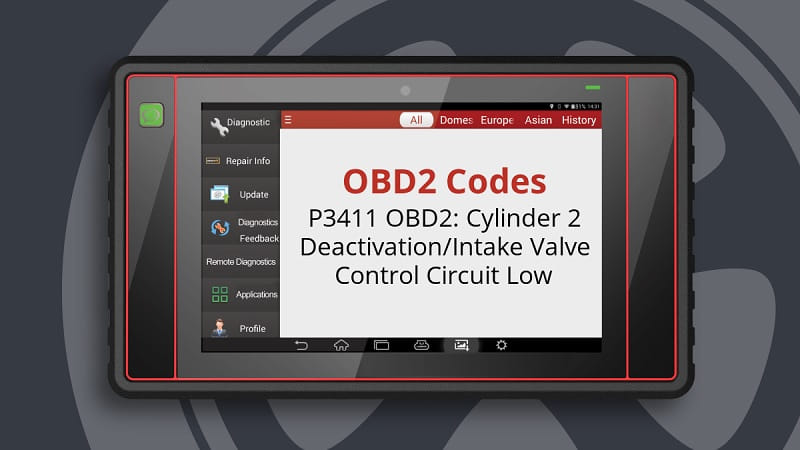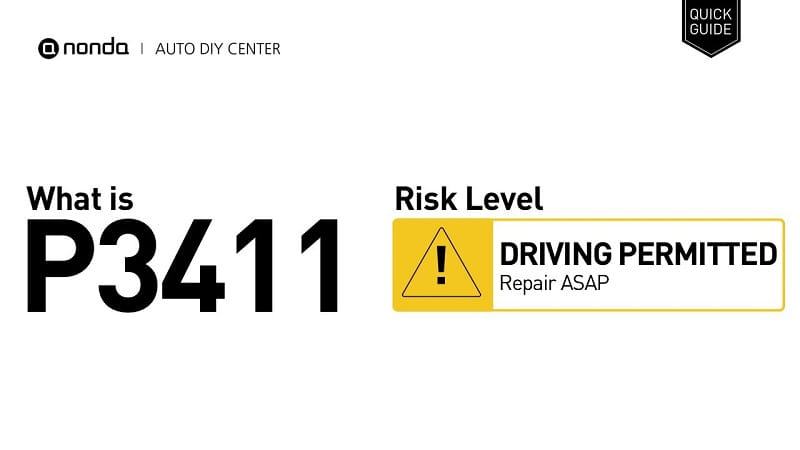This post contains affiliate links. This means I will make a commission at no extra cost to you should you click through and make a purchase [ “As an Amazon Associate, I earn from qualifying purchases.” ]. Read the full disclosure here.
Understanding Diagnostic Trouble Code P3411 Cylinder 2 Deactivation/Intake Valve Control Circuit Low GuideMechanic.Com Modern internal combustion engines are increasingly complex, featuring advanced systems that improve fuel efficiency and reduce emissions.
One such system is the cylinder deactivation system, which allows certain engine cylinders to shut off under light load conditions, conserving fuel and enhancing efficiency.
When these systems malfunction, the engine control module (ECM) stores specific diagnostic trouble codes (DTCs) to help identify the issue. One such DTC is P3411 – Cylinder 2 Deactivation/Intake Valve Control Circuit Low.
In this article, we will explore the meaning of the P3411 code, its possible causes, symptoms, diagnostic steps, and how it can be repaired.
See Also: P3412 Cylinder 2 Deactivation/Intake Valve Control Circuit High
P3411 Cylinder 2 Deactivation/Intake Valve Control Circuit Low
What Does P3411 Mean?

The DTC P3411 refers specifically to Cylinder 2’s deactivation or intake valve control circuit, indicating that the voltage in this circuit is lower than expected.
This usually points to an electrical problem, such as a short to ground or an open circuit, within the cylinder deactivation control mechanism.
Many modern engines—especially those from manufacturers like GM (General Motors) and Honda—use Variable Displacement Systems (VDS), Active Fuel Management (AFM), or Variable Cylinder Management (VCM) to disable specific cylinders under certain conditions.
These systems achieve deactivation by controlling oil pressure to special solenoids that operate intake and/or exhaust valves, effectively shutting off fuel and valve operation in targeted cylinders.
The ECM monitors these solenoids and expects voltage signals within a certain range. If it detects that the voltage for the Cylinder 2 intake valve control circuit is too low, it logs code P3411.
Common Symptoms of Code P3411
The P3411 code may produce noticeable or subtle symptoms depending on how the vehicle’s ECM responds to the fault. Common symptoms include:
- Check Engine Light (CEL): This is usually the first and most obvious sign. The light may remain solid or flash depending on the severity.
- Rough Idle: The engine may run unevenly due to improper valve timing or deactivation failure.
- Reduced Power: The engine may enter a limp mode to protect itself.
- Increased Fuel Consumption: If cylinder deactivation is not functioning correctly, fuel efficiency may drop.
- Engine Misfire: Particularly in cylinder 2, due to improper valve operation.
- Strange Noises: Ticking or tapping sounds may indicate solenoid or valve issues.
P3411 Cylinder 2 Deactivation/Intake Valve Control Circuit Low
Causes of Code P3411
Several issues can trigger a P3411 code. These include:
- Faulty Intake Valve Control Solenoid for Cylinder 2: A worn or malfunctioning solenoid is the most common cause.
- Wiring Problems: Frayed wires, open circuits, or short circuits in the control wiring harness.
- Poor Electrical Connections: Loose connectors or corroded pins at the solenoid or ECM.
- Low Engine Oil Pressure: Cylinder deactivation systems often rely on proper oil pressure to function. Low pressure can prevent activation.
- Clogged Oil Passages: Dirty or sludged oil may block passages to the solenoids.
- Faulty ECM/PCM: Rare, but possible if all other components are functioning properly.
- Aftermarket Modifications: Incompatible parts or tuning software may interfere with the system.
Diagnosing Code P3411
Proper diagnosis is essential to avoid unnecessary parts replacement. The following steps outline a typical diagnostic procedure:
- Scan for Codes: Use an OBD-II scanner to confirm the presence of P3411 and check for other related codes, such as misfire codes (P0302) or other VCM-related DTCs.
- Inspect Wiring and Connectors: Visually examine the wiring harness to Cylinder 2’s solenoid. Look for damage, corrosion, or loose connections.
- Test the Solenoid: Using a digital multimeter, check the resistance of the Cylinder 2 intake valve solenoid. Compare the reading with manufacturer specifications.
- Check Oil Level and Condition: Ensure the oil is at the proper level and is clean. Dirty or low oil can affect hydraulic systems.
- Perform a Continuity Test: Ensure there’s proper continuity in the circuit from the ECM to the solenoid.
- Use a Noid Light or Test Light: Check for voltage at the solenoid connector when the system is active.
- ECM Check: If everything checks out but the issue remains, further diagnosis of the ECM may be required.
P3411 Cylinder 2 Deactivation/Intake Valve Control Circuit Low
How to Fix Code P3411

Once the issue is accurately diagnosed, the appropriate repairs can be made. Possible fixes include:
- Replacing the Cylinder 2 Intake Valve Control Solenoid: If the solenoid is shorted or open, replacing it usually solves the issue.
- Repairing or Replacing Damaged Wiring: Fix any frayed, broken, or shorted wires in the solenoid control circuit.
- Cleaning or Replacing Connectors: Corroded or loose connectors should be cleaned or replaced.
- Changing the Engine Oil and Filter: Use manufacturer-recommended oil grade to ensure optimal hydraulic pressure.
- Cleaning Oil Passages: If oil passages are blocked, a full engine flush or manual cleaning may be required.
- ECM Replacement or Reprogramming: This should be a last resort after all other possibilities are ruled out.
P3411 Cylinder 2 Deactivation/Intake Valve Control Circuit Low
Preventing P3411 and Related Issues
Preventive maintenance plays a key role in avoiding P3411 and similar DTCs. Here are some tips:
- Use High-Quality Oil: Always use the oil recommended by the vehicle manufacturer. Improper oil viscosity can affect the operation of solenoids and lifters.
- Change Oil Regularly: Dirty oil is the primary enemy of variable valve timing and deactivation systems.
- Inspect Electrical Systems: During routine maintenance, inspect wiring harnesses and connectors for early signs of wear or corrosion.
- Avoid Unnecessary Modifications: Aftermarket tuning, oil additives, or incompatible engine components can disrupt factory systems.
- Stay Informed About Recalls or TSBs: Some vehicles may have technical service bulletins (TSBs) or recalls for known cylinder deactivation issues.
Conclusion
The P3411 – Cylinder 2 Deactivation/Intake Valve Control Circuit Low code is an important alert that shouldn’t be ignored. It often signals an issue within the cylinder deactivation system—specifically in the electrical circuit that controls the intake valve on Cylinder 2.
Addressing this code promptly can prevent more serious engine performance problems, protect fuel economy, and ensure your engine runs smoothly.
By understanding the symptoms, causes, and steps for diagnosis and repair, vehicle owners and technicians can approach P3411 with confidence and clarity.
As with all DTCs, accurate troubleshooting is essential to avoid costly misdiagnoses and unnecessary repairs. Regular maintenance and attention to your engine’s oil and electrical health are key to keeping your cylinder deactivation system working reliably for the long haul.
- 4×4 Truck for Sale Used - October 21, 2025
- 4×4 Truck for Sale Under 20K - October 15, 2025
- 4×4 Truck for Sale QLD - October 12, 2025
